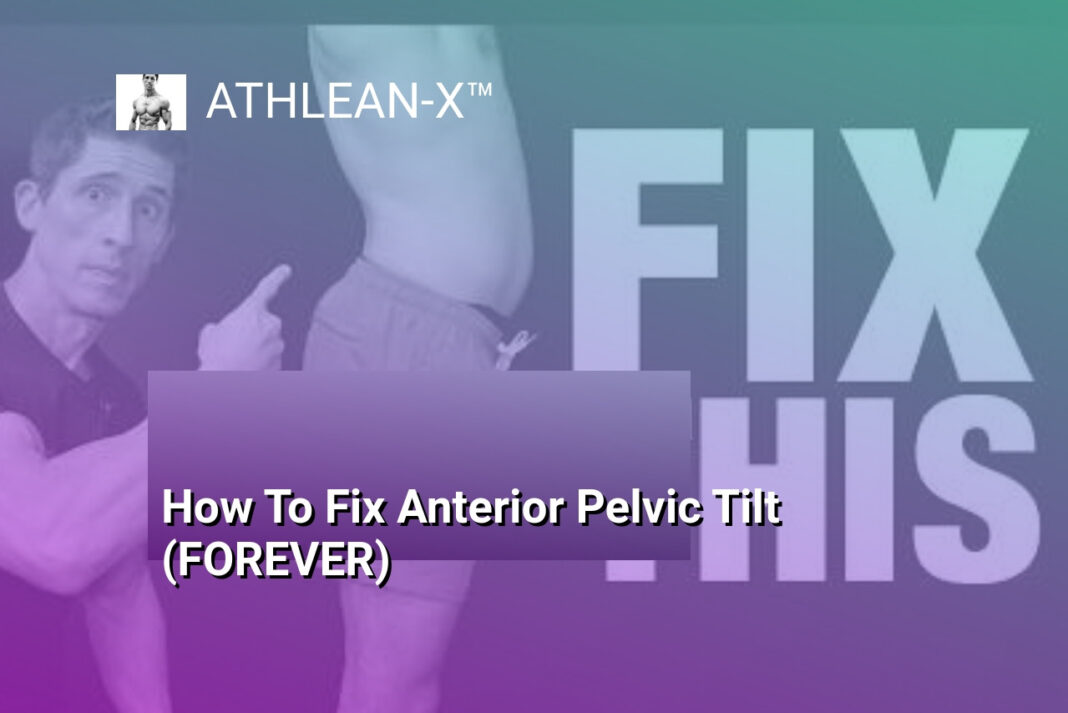The Bottom Line:
- The article discusses the common issue of anterior pelvic tilt, which affects around 75% of the population, and can lead to lower back pain and other problems if left untreated.
- The author provides a four-step plan to help fix anterior pelvic tilt, including stretching tight hip flexors and lower back muscles, strengthening the abdominal muscles without overworking the hip flexors, and activating the glutes.
- The author emphasizes the importance of addressing the root causes of anterior pelvic tilt, rather than just stretching the hamstrings, which is a common but ineffective approach.
- The article includes detailed instructions and demonstrations for the recommended exercises and stretches, making it easy for readers to follow and implement the plan.
- The author encourages readers to be consistent with the exercises and stretches, as well as to seek further guidance if needed, in order to achieve long-term relief from anterior pelvic tilt and its associated issues.
Identifying Anterior Pelvic Tilt
Recognizing the Signs of Anterior Pelvic Tilt
Identifying anterior pelvic tilt can be a straightforward process. One of the easiest ways to detect it is by observing your posture from the side. If you notice that your lower back appears to be arched, and your belly is protruding forward, it’s a strong indication that you may be dealing with anterior pelvic tilt.
Assessing Anterior Pelvic Tilt through Self-Examination
Another way to assess your anterior pelvic tilt is by performing a simple self-examination. Lie down on the ground and try to slide your hands underneath your lower back. If you can easily fit your hands under your back, it’s a clear sign that your pelvis is tilted forward. Conversely, if you struggle to fit your hands under your back, it suggests that your pelvis is in a more neutral position.
Understanding the Contributing Factors
Anterior pelvic tilt is often the result of a combination of factors. Tight hip flexors, which can be exacerbated by prolonged sitting, can pull the pelvis forward, leading to the characteristic arched lower back. Additionally, weak glute muscles can contribute to the issue, as they play a crucial role in maintaining proper pelvic alignment. Finally, the protruding belly that often accompanies anterior pelvic tilt can be a result of the postural imbalance, rather than just excess body fat.
By understanding these contributing factors, you can develop a targeted approach to addressing and correcting your anterior pelvic tilt, which is essential for maintaining overall spinal health and preventing related issues, such as lower back pain.
Tight Hip Flexors and Low Back Muscles
Addressing Tight Hip Flexors and Low Back Muscles
The tight hip flexors and low back muscles are often contributors to the anterior pelvic tilt condition. The hip flexors, which attach to the lower back and run down the front of the thighs, can become shortened and tight due to prolonged sitting. This can pull the pelvis into an anterior tilt, causing the lower back to arch and the muscles in that area to become tight and sore.
To address the tight hip flexors, a kneeling overhead reach stretch can be very effective. By kneeling with one knee on the ground and reaching the arm on that side overhead, you can feel a deep stretch in the hip flexor of the kneeling leg. Holding this stretch for 60-90 seconds, a few times per day, can help to lengthen and release the tight hip flexors.
In addition to the hip flexors, the low back muscles can also become tight and restricted in an anterior pelvic tilt. A simple double-knee chest stretch can help to release tension in the lumbar paraspinal muscles. By pulling both knees into the chest while lying on the back, you can feel a gentle stretch through the lower back.
Strengthening the Abdominal Muscles
While stretching the tight muscles is important, it’s also crucial to address the weaknesses that contribute to the anterior pelvic tilt. One of the key weaknesses is often in the abdominal muscles. However, it’s important to target the abs in a way that doesn’t overwork the hip flexors, which can further exacerbate the issue.
Two effective exercises for strengthening the abs without overloading the hip flexors are the banded crunch and the “swiper” exercise. The banded crunch involves anchoring a resistance band behind the ankles and then performing a crunch, pulling back against the band to engage the posterior chain and avoid excessive hip flexor activation. The swiper exercise focuses on curling the pelvis towards the shoulders, rather than just lifting the legs, to isolate the lower abdominal muscles.
Strengthening the Glutes
Another crucial component in addressing the anterior pelvic tilt is strengthening the glute muscles. When the pelvis is tilted forward, the glutes can become disengaged and weak. Two exercises that can help to reactivate and strengthen the glutes are the bridge and reach, and the sprinter’s stretch lunge.
The bridge and reach exercise involves performing a glute bridge while reaching the arm across the body, which helps to stretch the hip flexor on the opposite side. The sprinter’s stretch lunge, on the other hand, focuses on strengthening the glutes while also stretching the hip flexor of the back leg.
By addressing the tight hip flexors and low back muscles, strengthening the abdominal and glute muscles, you can work towards restoring a more neutral pelvic alignment and alleviating the discomfort associated with anterior pelvic tilt.
Strengthening the Core and Glutes
Strengthening the Core and Glutes
To effectively address anterior pelvic tilt, it’s crucial to focus on strengthening the core and glutes. This can be achieved through targeted exercises that not only build strength but also help restore proper pelvic alignment.
Strengthening the Core
One of the key exercises to target the core without overworking the hip flexors is the banded crunch. Start by anchoring a resistance band in front of you and placing it behind your ankles. Lie down and perform a regular crunch, but before lifting, pull back against the band, engaging the posterior chain. This helps to turn off the hip flexors and forces the abdominal muscles to do the majority of the work.
Another effective exercise is the “swiper.” Instead of performing traditional leg lifts, which can overwork the hip flexors, focus on curling the pelvis towards the shoulders while keeping the hands underneath. This isolates the lower abdominal muscles and helps to stabilize the pelvis.
Strengthening the Glutes
To strengthen the glutes, the bridge and reach exercise is a great option. Start in a bridge position, lifting your hips off the ground and squeezing the glutes. As you hold the bridge, reach your arm across your body, towards the opposite shoulder. This not only works the glutes but also helps to stretch the hip flexor on the opposite side.
Another exercise to target the glutes is the Sprinter’s Lunge. Start in a lunge position with one leg back. As you drive back up, focus on squeezing the glute of the front leg. This movement helps to strengthen the glutes while also stretching the hip flexor on the back leg.
By incorporating these core and glute-strengthening exercises into your routine, you can effectively address the underlying weaknesses that contribute to anterior pelvic tilt. Remember to be consistent and patient, as it may take time to see significant improvements in your posture and overall pelvic alignment.
Stretching for Flexibility
Stretching for Flexibility
To address the tight muscles associated with anterior pelvic tilt, we’ll start with a couple of stretches. The first is the kneeling overhead reach stretch. Get down on one knee, lean forward, and reach the arm on the same side overhead, feeling a stretch in the hip flexor. Hold this for 60-90 seconds, then switch sides.
Next, we’ll target the tight low back muscles with a double-knee chest stretch. From the previous position, simply lie back and pull both knees in towards your chest, feeling the stretch in the lumbar region. Again, hold for 60-90 seconds.
Strengthening the Core
While stretching the tight muscles is important, we also need to focus on strengthening the core to help correct the anterior pelvic tilt. However, we want to be strategic about this to avoid overworking the hip flexors.
One exercise is the banded crunch. Anchor a resistance band behind your ankles, then perform a crunch while pulling back against the band. This helps engage the abdominal muscles without excessive hip flexor activation.
Another core exercise is the “swiper.” Instead of lifting your legs straight up, focus on curling your pelvis towards your shoulders, keeping your lower back flat on the floor. This isolates the lower abdominal muscles.
Strengthening the Glutes
The final piece of the puzzle is strengthening the glutes, which tend to become weak in those with anterior pelvic tilt. Start with the bridge and reach, reaching your arm across your body as you drive through your heels to lift your hips. Focus on squeezing the glutes at the top.
The sprinter’s stretch lunge is another great glute-strengthening exercise. Step one leg back, keeping your torso upright, and lean forward to feel a stretch in the front of the hip. As you drive back up, squeeze the glute of the working leg.
Perform these exercises consistently, and you’ll be well on your way to correcting your anterior pelvic tilt and alleviating any associated discomfort.
Putting It All Together
Addressing Tight Muscles
To address the tight muscles contributing to your anterior pelvic tilt, we’ll focus on two key areas: the hip flexors and the low back.
For the tight hip flexors, the kneeling overhead reach stretch is an effective solution. Start by kneeling on one knee, lean forward, and reach the arm on the same side overhead, feeling the stretch in the front of your hip. Hold this stretch for 60-90 seconds, and repeat on the other side.
To address the tight low back, a simple double-knee chest stretch can provide relief. From the previous position, lie on your back and pull both knees towards your chest, feeling the stretch in your lower back. Hold this stretch for 60-90 seconds as well.
Strengthening the Abdominal Muscles
When it comes to strengthening the abdominal muscles without overworking the hip flexors, two exercises are particularly effective. The first is a banded crunch, where you anchor a resistance band behind your ankles and perform crunches while pulling back against the band. This helps engage the abdominal muscles while minimizing hip flexor involvement.
The second exercise is the “swiper,” where you focus on curling your pelvis towards your shoulders rather than simply lifting your legs. This isolates the lower abdominal muscles and avoids excessive hip flexor activation.
Strengthening the Glutes
To address the weak glutes, we’ll incorporate two exercises. The first is the bridge and reach, where you perform a glute bridge while reaching your arm across your body. This not only strengthens the glutes but also provides a gentle stretch for the hip flexors.
The second exercise is the sprinter’s lunge, where you step one leg back, keeping your torso upright. As you lean forward, you’ll feel a stretch in the hip flexor of the back leg, while the glute of the front leg works to drive you back up to the starting position. Perform 10-12 reps per leg for 2-3 sets.
By addressing the tight muscles, strengthening the abdominal and glute muscles, and incorporating these targeted exercises, you can effectively address your anterior pelvic tilt and start feeling better.





